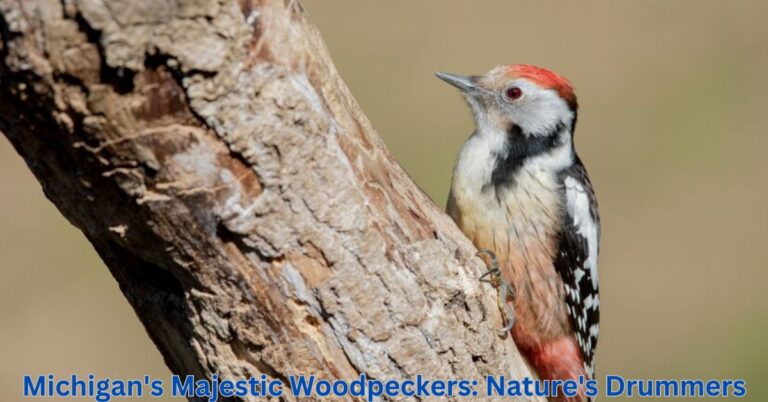Michigan’s diverse landscape, filled with lush forests, rolling hills, and wetlands, provides a perfect environment for several species of woodpeckers. These birds are easily recognized by their strong beaks, zygodactyl feet (two toes pointing forward and two backward), and the rhythmic drumming sounds they produce as they hammer into tree trunks.
Woodpeckers in Michigan are not just important members of the bird community but also contribute significantly to forest health by controlling insect populations and creating nesting habitats for other species.
The Role of Woodpeckers in Ecosystems
Woodpeckers are keystone species in many ecosystems, meaning their activities benefit numerous other organisms. By pecking into trees in search of insects, they help manage pests, reducing damage to trees and other plant life. Their excavated cavities become homes for various animals, including other bird species, mammals, and even some reptiles. In essence, woodpeckers help maintain balance in Michigan’s forests.
Common Woodpecker Species in Michigan
Michigan is home to several notable woodpecker species, each with its unique characteristics and behavior. Below are some of the most commonly observed species.
1. Downy Woodpecker
The Downy Woodpecker is the smallest woodpecker species found in Michigan, measuring around 6-7 inches in length. Despite its small size, it’s easily recognizable due to its black-and-white plumage and the red patch found on the nape of males. Downy Woodpeckers are common in forests, suburban areas, and even city parks, making them one of the most visible species in Michigan.
Habitat and Behavior
Downy Woodpeckers are highly adaptable, thriving in a variety of habitats, from dense woodlands to backyard feeders. They forage on insects such as beetles, ants, and caterpillars, as well as seeds and berries. These birds are often spotted hopping along tree trunks, where their small size allows them to reach insects that larger woodpeckers might miss.
2. Hairy Woodpecker
Closely resembling the Downy Woodpecker but slightly larger, the Hairy Woodpecker is another common species in Michigan. Measuring around 9-10 inches in length, the Hairy Woodpecker is known for its sharp, strong beak and similar black-and-white coloration.
Habitat and Behavior
Hairy Woodpeckers prefer mature forests, particularly those with dead or dying trees that provide rich sources of insects. Unlike the Downy, Hairy Woodpeckers tend to be more reclusive, often staying high in the trees. They are excellent at controlling wood-boring insects, helping to keep forest ecosystems healthy.
3. Red-Bellied Woodpecker
The Red-Bellied Woodpecker is a striking bird with a pale, grayish face, a bright red crown, and a faint reddish tinge on its belly, which gives it its name. These medium-sized woodpeckers are larger than the Downy and Hairy Woodpeckers, typically measuring around 9-10.5 inches in length.
Habitat and Behavior
Red-Bellied Woodpeckers are commonly found in hardwood forests, where they forage for insects, fruits, seeds, and occasionally, even small lizards or birds. Their loud, rolling calls make them easy to spot, and they are known for their habit of storing food in tree crevices.
4. Northern Flicker
The Northern Flicker is one of the more unusual woodpeckers found in Michigan because it forages primarily on the ground. This large woodpecker, measuring up to 12 inches, has a distinctive brown and black barred back, a white rump, and a bright yellow or red underwing depending on the subspecies.
Habitat and Behavior
Northern Flickers prefer open woodlands, edges of forests, and even urban areas. Unlike most woodpeckers, they feed primarily on ants and beetles found in the soil, which they dig up with their long, barbed tongues. Their loud, repetitive calls and dramatic flight patterns make them a favorite among birdwatchers.
5. Pileated Woodpecker
The Pileated Woodpecker is the largest woodpecker species in Michigan, known for its size, powerful drumming, and its bold, black-and-white plumage topped with a striking red crest. Measuring up to 19 inches in length, it is one of the most impressive birds in the state.
Habitat and Behavior
Pileated Woodpeckers require large tracts of mature forest with plenty of dead trees and downed logs. They use their strong bills to excavate deep holes in search of carpenter ants and other insects. Their presence is often signaled by large rectangular holes in tree trunks and their loud, distinctive calls that echo through the forest.
The Drumming Phenomenon
One of the defining characteristics of woodpeckers is their drumming behavior. This rhythmic tapping is not only a way to forage for food but also serves as a communication tool. Woodpeckers drum to establish territory, attract mates, and even ward off potential rivals. The sound is created by the bird repeatedly striking its beak against a hard surface, such as a tree trunk or branch. Each species of woodpecker has its unique drumming pattern, which experienced birdwatchers can identify by sound alone.
Conservation and Protection of Michigan’s Woodpeckers
While woodpeckers are widespread across Michigan, they face threats from habitat loss, climate change, and human activities. Logging, urban development, and the removal of dead trees reduce the availability of suitable nesting and foraging sites. Conservation efforts focus on protecting old-growth forests and promoting the retention of deadwood in forest management practices.
What You Can Do to Help
Supporting woodpecker conservation in Michigan can be as simple as leaving dead trees and snags intact in forests and suburban areas, as these provide essential nesting sites and foraging opportunities. Homeowners can also put up bird feeders stocked with suet and nuts, which are favorite food sources for many woodpeckers, especially in the winter months.
Conclusion
Michigan’s majestic woodpeckers are more than just beautiful birds; they are vital contributors to the health and balance of forest ecosystems. From the tiny Downy Woodpecker to the impressive Pileated Woodpecker, these species display incredible adaptability, resilience, and ecological importance. By appreciating and protecting their habitats, we ensure that future generations can continue to enjoy the sights and sounds of nature’s drummers in Michigan’s great outdoors.
ALSO READ: MovieOrca: Dive Deep into Cinema’s Best

